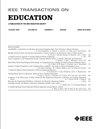学生计算思维游戏解决方案的形式概念分析
IF 2
2区 工程技术
Q2 EDUCATION, SCIENTIFIC DISCIPLINES
引用次数: 0
摘要
贡献:我们为教师提供了一个框架,以调查学生在解决问题或计算思维过程中解决方案的属性之间的关系。我们提供可视化和评估技术,以发现学生解决方案中的隐藏模式,使教师能够预测学生的具体行为,或提前防止学生的一些错误或误解或进一步的教学干预。背景:形式概念分析是一种无监督机器学习方法,它应用数学格理论来组织基于对象及其共享属性的数据。形式概念分析的几个模糊扩展具有很大的潜力,可以可视化和评估学生的解决方案,将解决方案分类为重叠的双聚类(形式概念)或在提取的属性之间生成属性含义。研究问题:在教育和计算思维游戏Light-Bot中,形式概念分析是否描述了各种解决方案以及学生解决方案的提取属性之间的关系?方法:针对64名学生在Light-Bot游戏中的解决方案的评估,我们构建了提取属性的形式上下文。我们运用形式概念分析从两个二元形式上下文中构造概念格,并生成属性含义及其模糊对应项,以找出提取属性之间的依赖关系。结果:本论文的结果提供了在概念格中可视化的各种学生解决方案的描述。1)对于二元形式上下文的概念格,我们得到了包含最大相似解群的描述的最大双聚类的特征。2)属性含义主要揭示了相似解决方案的特征,例如,解决方案中执行命令的数量较高。3)利用模糊属性暗示,得到了非必要命令解、走出博弈区域解和间接递归解的特征。本文章由计算机程序翻译,如有差异,请以英文原文为准。
Formal Concept Analysis of Students’ Solutions on Computational Thinking Game
Contribution: We present a framework for teachers to investigate the relationships between attributes of students’ solutions in the process of problem solving or computational thinking. We provide visualization and evaluation techniques to find hidden patterns in the students’ solutions which allow teachers to predict the specific behavior of students or to prevent some student mistakes or misconceptions in advance or further pedagogical intervention. Background: Formal concept analysis is a method of unsupervised Machine Learning that applies mathematical lattice theory to organize data based on objects and their shared attributes. Several fuzzy extensions of formal concept analysis have a great potential to visualize and evaluate students’ solutions, to categorize the solutions into overlapping biclusters (formal concepts) or to generate the attribute implications between extracted attributes. Research Question: Does formal concept analysis describe the various solutions and the relationships between the extracted attributes of students’ solutions in the educational and computational thinking game Light-Bot? Methodology: Targeting the evaluation of 64 students’ solutions in the Light-Bot game, we construct the formal contexts of the extracted attributes. We apply formal concept analysis to construct the concept lattices from two binary formal contexts and to generate attribute implications and their fuzzy counterparts to find the dependencies between the extracted attributes. Findings: The results of our paper provide a description of various students’ solutions which are visualized in the concept lattices. 1) Regarding the concept lattice of binary formal contexts, we obtained the characterization of the largest biclusters which includes a description of the largest group of similar solutions. 2) The attribute implications mainly reveal the characterization of similar solutions, e.g., with a higher count of executed commands in solutions. 3) Using fuzzy attribute implications, we obtained the characterization of solutions with unnecessary commands, going out of the game area, or using indirect recursion.
求助全文
通过发布文献求助,成功后即可免费获取论文全文。
去求助
来源期刊

IEEE Transactions on Education
工程技术-工程:电子与电气
CiteScore
5.80
自引率
7.70%
发文量
90
审稿时长
1 months
期刊介绍:
The IEEE Transactions on Education (ToE) publishes significant and original scholarly contributions to education in electrical and electronics engineering, computer engineering, computer science, and other fields within the scope of interest of IEEE. Contributions must address discovery, integration, and/or application of knowledge in education in these fields. Articles must support contributions and assertions with compelling evidence and provide explicit, transparent descriptions of the processes through which the evidence is collected, analyzed, and interpreted. While characteristics of compelling evidence cannot be described to address every conceivable situation, generally assessment of the work being reported must go beyond student self-report and attitudinal data.
 求助内容:
求助内容: 应助结果提醒方式:
应助结果提醒方式:


